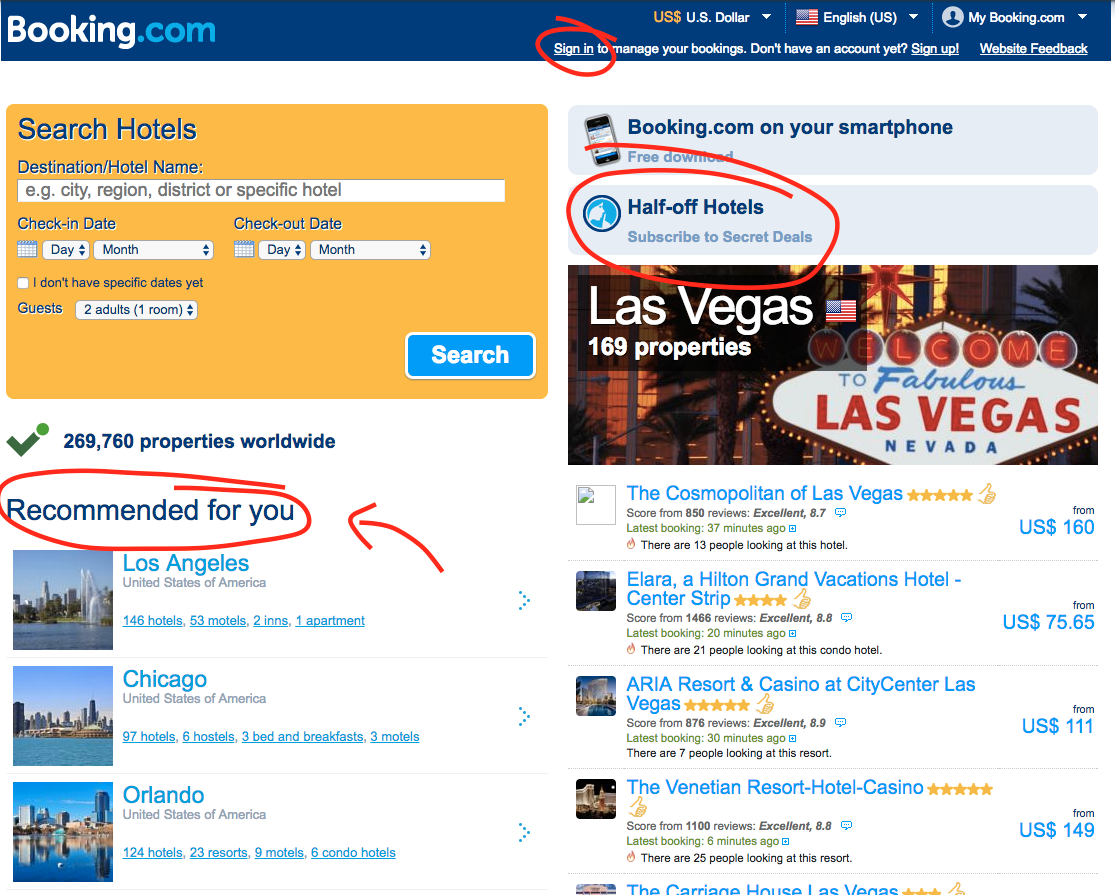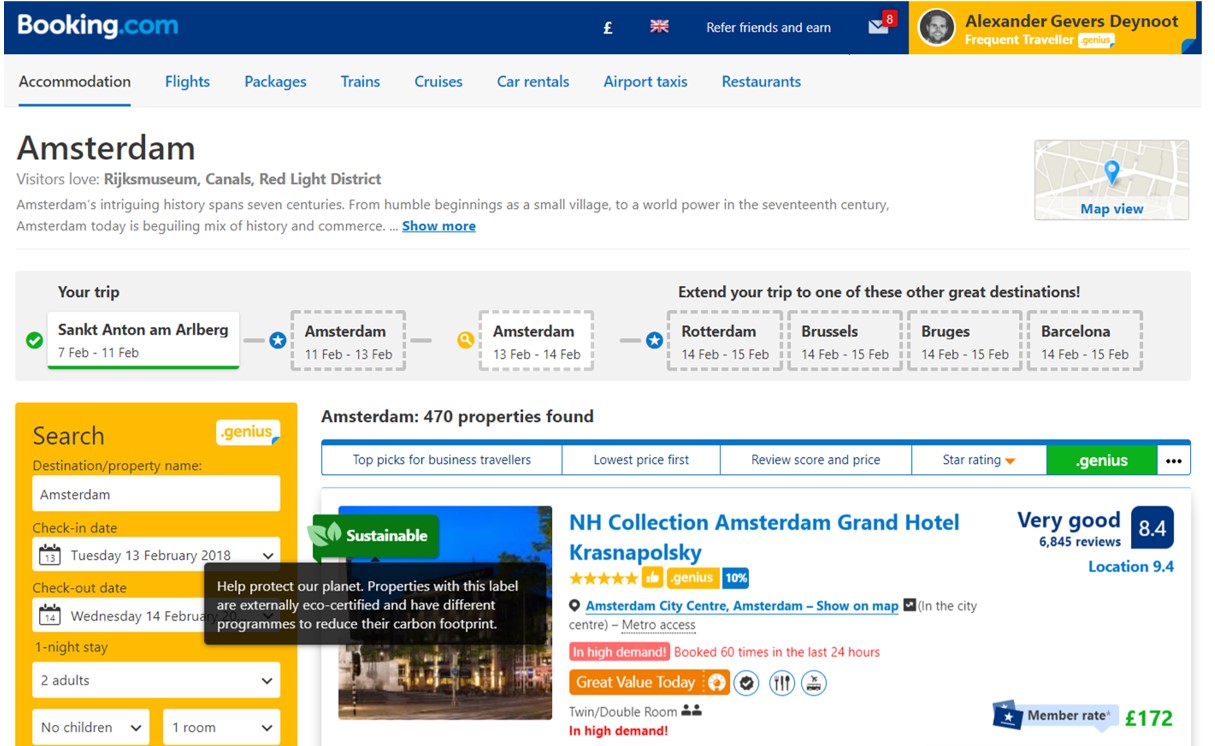The online travel industry is a highly competitive place. Brand loyalty is hard-won and quite easily lost. On top of that, consumer attention spans are fickle. Online travel platforms are in need of design that to convert visitors into loyal, committed customers. But how to do that?
How to optimize design for human motivation so that conversions shine over dropoffs?
This challenge was already there for Booking.com in 2015. The company needed to not only draw visitors to its platform but also ensure they proceeded to make bookings. The imperative was clear – transform the casual site visitor into a customer, and do it efficiently and consistently.
Booking engaged with The Octalysis Group to get insight into how to use Octalysis as a strategic lever to influence consumer behavior. The Octalysis-Booking.com cooperation was very much about applying behavioral science and gamification principles long before both terms became buzzwords.
But even more so the cooperation was about fundamentally rethinking how a website interacts with its users. It’s about understanding the subtle triggers that convert passive interest into active decision-making. Let’s explore how we applied our unique blend of behavioral psychology, innovative gamification strategies, and user-focused design to redefine the Booking.com website.
The transformation of Booking.com’s website in 2015 has not only led to a huge increase in user conversions but also set a new benchmark in the industry. It stands as a shining example of how a well-thought-out gamification strategy, deeply rooted in understanding user behavior and motivations, can lead to significant business outcomes. It also shows clearly that applying Gamification need not look “gamey” or silly. Designed well, this type of Gamification keeps the engagement without feeling like a game.
In a broader sense, this case study is a testament to the evolving nature of digital consumer engagement. It underscores the shift from conventional marketing tactics to more sophisticated, psychology-based approaches to user interaction. The success of Booking.com after The Octalysis Group’s intervention now gives other platform the confidence to do similar design changes.
Maximizing Conversions in a Competitive Space
The challenge that Booking.com faced was demanding, particularly in the context of the travel and accommodation industry. Travel is not an everyday activity for most people. Planning trips and booking accommodations are typically infrequent activities, often tied to annual vacations, occasional business trips, or sporadic weekend getaways.
The sporadic nature of travel bookings posed a unique challenge: how do you design a user experience that not only attracts visitors but also persuades them, almost compellingly, to complete a booking during their infrequent visits?
The challenge was further intensified by the choice paralysis by consumers. With a myriad of booking platforms just a click away, capturing user attention was only the first step. The more daunting task was to swiftly guide them from browsing to booking, all within the limited span of a single visit.
Booking.com needed a strategy that could break through the clutter, grab user attention, and lead them down a seamless path culminating in a booking. This journey had to be intuitive, persuasive, and rewarding enough to make users choose Booking.com over its competitors, time and again.
Moreover, the strategy had to be adaptable, catering to a diverse global audience with varied travel needs and behaviors. It had to account for different user intents – from those merely seeking inspiration to those with a clear destination in mind.
The goal was clear – make every visit count. In every user interaction, there lay an opportunity to convert interest into a booking. The task at hand was not just about creating an attractive website, but about engineering a user experience that was compelling enough to transform passive interest into active bookings.
Their site in 2014/15 wasn’t bad, it just was not optimised for human motivation:
There were some nascent design gems that coud lead to stronger and lasting conversions. The “Recommended for you” and “There are xx people looking at this hotel” are good uses of leveraging Social Proof to get people interested.
However, the issue with the pre-2015 design is that there is not enough Black Hat design. So although people got interested in the hotel deal, there was no design that actually motivated users to book the hotel room NOW. That was about to change due to Octalysis….
The Psychology Behind the Strategy
In their design approach, The Octalysis Group focused deeply on Extrinsic Motivation and Black Hat Core Drives.
Extrinsic Motivation, involves incentives or rewards that come from outside the individual, rather than from the intrinsic pleasure of the activity itself. This type of motivation is highly effective in situations where targeted and efficient action is desired, making it a perfect fit for Booking.com’s need to drive efficient booking decisions.
The Black Hat Core Drives, in turn, are psychological triggers that create a sense of urgency. These drives, which include scarcity, impatience, avoidance (like Fear of Missing Out – FOMO), can powerfully influence immediate decision-making and action. The Octalysis Group understood that leveraging these drives weree key to transforming user behavior on Booking.com.
The underlying psychological principles driving this strategy are well-documented in behavioral psychology. The scarcity principle asserts that people assign more value to things that are perceived as rare or in short supply. This principle, combined with the urgency triggered the wish to have something you cannot have yet, creates a potent motivational force.
By creating a sense of urgency and scarcity, the website subtly influenced user behavior, guiding them towards quicker booking decisions. This strategy was not just about making the site more visually appealing or user-friendly; It was a strategic, psychology-driven approach aimed at capitalizing on the very human tendencies that drive decision-making, resulting in a significant impact on conversion rates and user engagement.
The Redesign: a Sense of Urgency and Scarcity
The redesigned Booking.com website masterfully integrated these psychological concepts. Upon arrival, users were immediately presented with dynamic and time-sensitive notifications offering discounts or limited-time offers. This not only created a perception of immediate value but also tapped into the users’ fear of missing out on a great deal.
Moreover, the website included real-time updates showing how many people were viewing the same accommodation or how many rooms were left at a particular price. This not only fostered a sense of scarcity but also subtly introduced a competitive element, nudging users toward making a prompt booking decision to avoid losing out.
Look at the design below. You instantly get drawn in by the discount offered to you as a “special member”. At the same time the site cries out at you to make a decision. Do not miss out. Your room has already been booked 60 times in the last hour and is about to be sold out…
You can feel the immediate impact of applying Octalysis Human Focused Design on user motivation.
We are pulled in by Extrinsic Motivational Design and a ton of Black Hat Design elements. Discounted price, popular location, high demand, FOMO.
Add some Core Drive 5: Social Influence and Relatedness (6,845 Reviews, all Very Good, 8.4).
As a cherry on the pie we see a bit of Feel Good White Hat design: your hotek of choice is “Sustainable! (Core Drive 1: Epic Meaning and Calling).
No wonder Booking’s revenue shot up a lot but. by how much?
Quantifying the Impact
Booking.com’s financial and customer growth metrics after the redesign offer concrete evidence of success. In the years following the redesign, which began impacting user experience around 2015, Booking.com witnessed substantial growth in both customer base and financial returns.
Here are some key figures from Booking Holdings’ annual reports for the years after the redesign:
Gross Profit
2015: $8.4 billion
2019: $15.1 billion (up 80% from 2015)
Room Nights Booked
2015: $477.5 million
2016: $557.4 million (up 16.7% from 2015)
2017: $673.6 million (up 20.9% from 2016)
Total Gross Bookings:
2015: $51.5 billion
2016: $68.7 billion (up 33.4% from 2015)
2017: $81.2 billion (up 18.2% from 2016)
Great numbers indeed and a testament to the great leadership at Booking.com, and proof that good design can lead to very good results indeed.
Setting a New Industry Standard
The increase in conversion rates and customer growth set a new standard in the travel booking industry. Competitors and peers began to take note of the effectiveness of using gamification for conversion optimization. This approach, pioneered by Booking.com, demonstrated that a strategic, psychology-driven design could have more impact than traditional marketing or sales strategies.
The success of Booking.com influenced how other companies in the travel and broader e-commerce sector approached website design and user experience. The use of urgency and scarcity, combined with rewards and competitive elements, became more prevalent as businesses sought to replicate Booking.com’s success.
Octalysis Impact since 2015
After the engagement with Booking.com, The Octalysis Group has worked with many other companies in the travel industry to great success: Hilton; La Quinta; LATAM Airlines, Amadeus. Some sample ROIs:
-
-
-
- 712 % Sales Growth
- 123% Miles Accumulation versus control group
- 153% Loyalty Cards Growth
-
-
With over a decade of experience in the sector we are now seen as a travel and loyalty design authority. But we do more than that:
Employee Engagement
Health and Wellbeing Application Design
Digital Transformation and Innovation De-Risking
Learning and Development
Curious how we can leverage our experience to uplift your business? Contact us.






